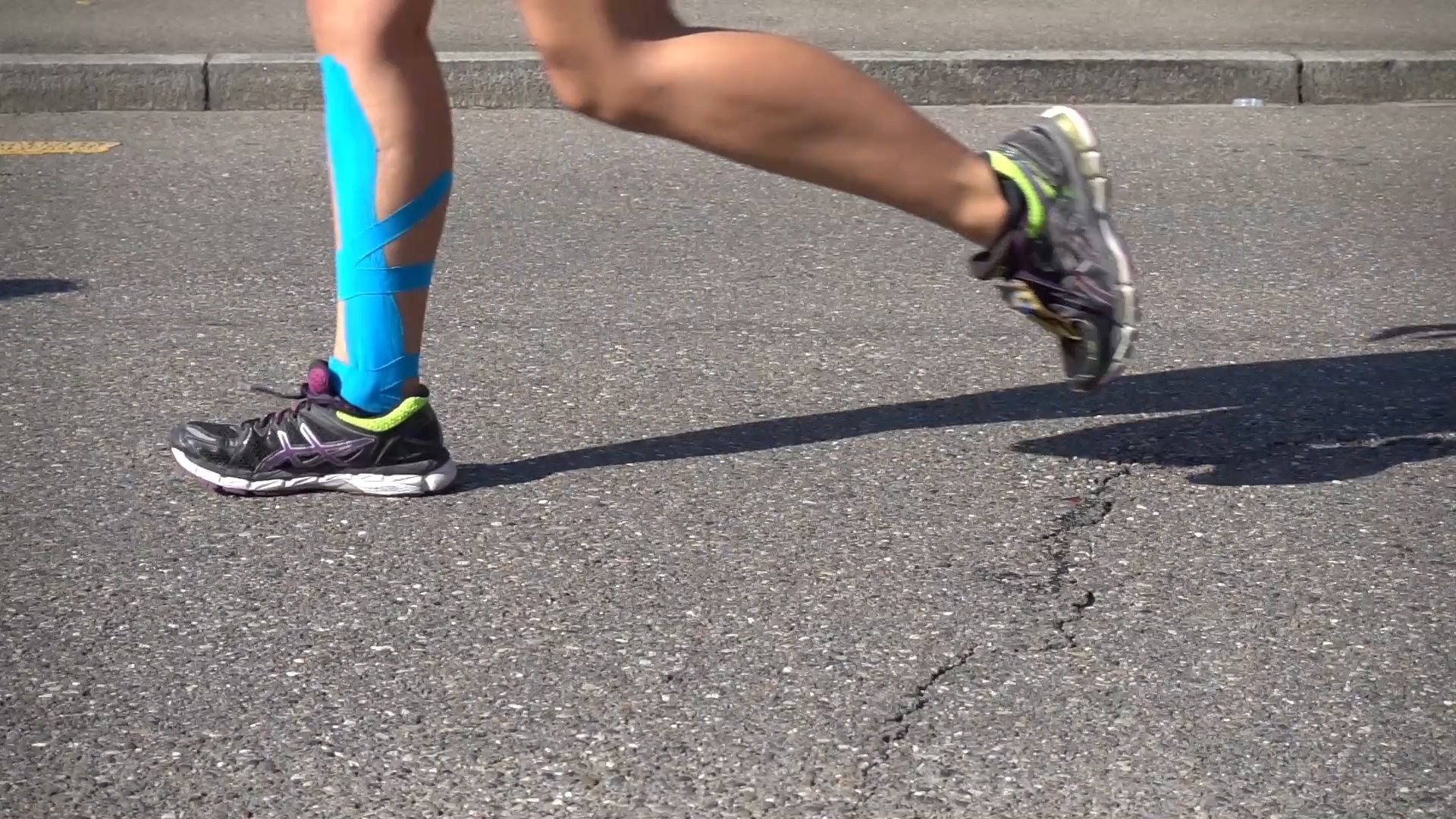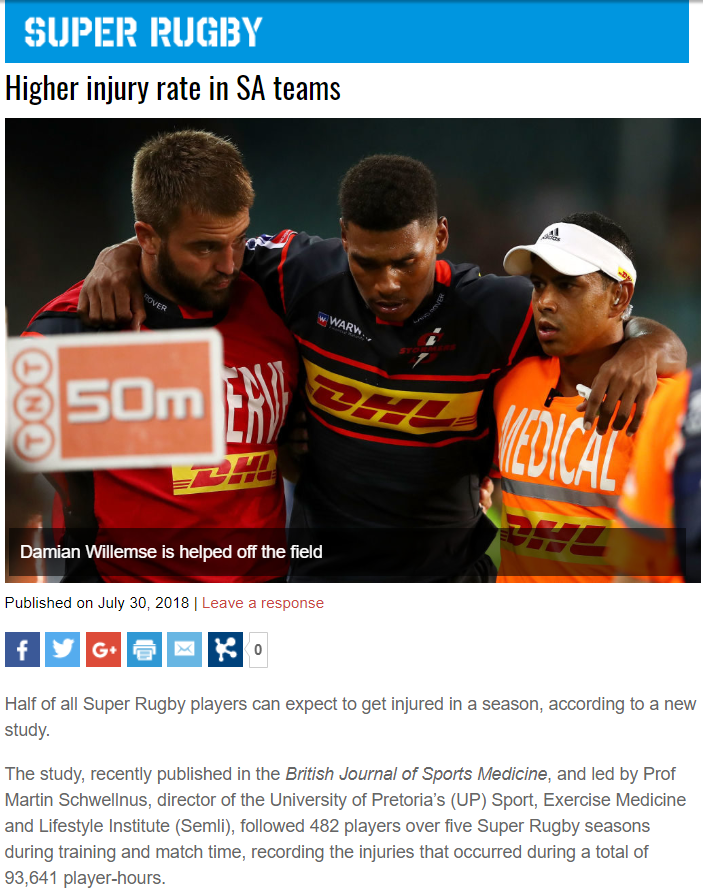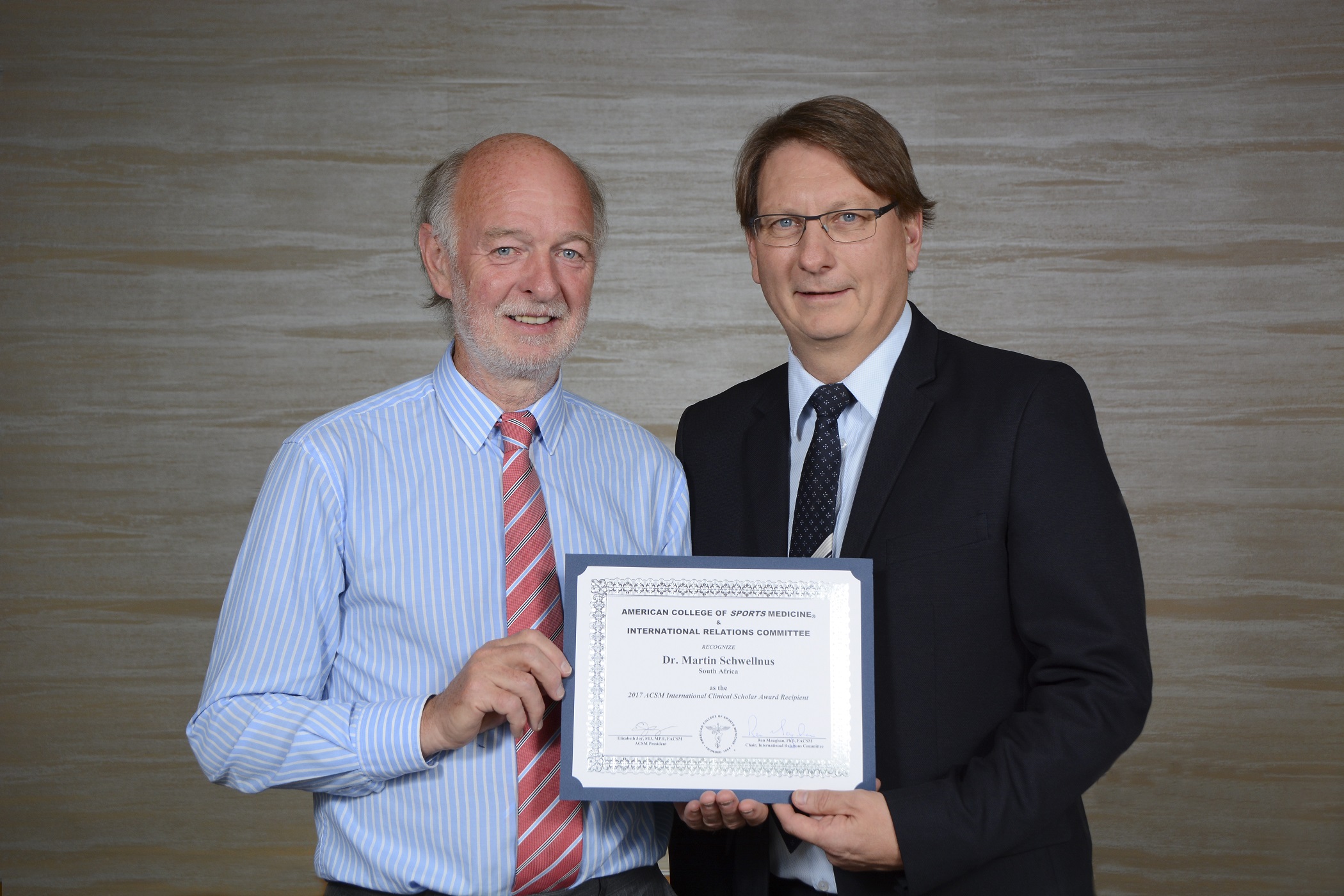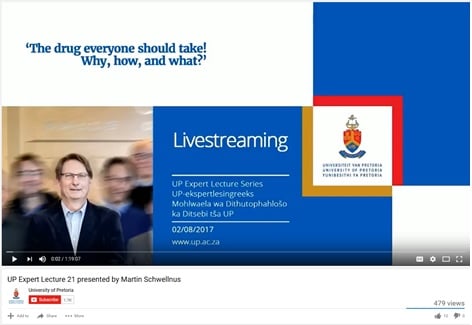 For the average marathon runner, excruciating pain is often inevitable during endurance runs, and popping a few painkillers before or during a race to make the pain more bearable seems like a no-brainer and is quite common.
For the average marathon runner, excruciating pain is often inevitable during endurance runs, and popping a few painkillers before or during a race to make the pain more bearable seems like a no-brainer and is quite common.
But a recent collaborative study by UP Sport, Exercise, Medicine and Lifestyle Institute (SEMLI) has raised concerns that neither athletes nor race organisers realise the severity and health risks of taking painkillers at the starting line and during the race.
“Runners are using these medicines for pain relief, injury prophylaxis, completing the race, faster recovery and because they’re under the impression that it will result in an earlier return to training after injury or improve athletic performance,” says SEMLI Director Professor Martin Schwellnus.
But the adverse consequences and side effects of these drugs – known as analgesic/anti-inflammatory medication (AAIM) – are often greatly underestimated. “Many are over-the-counter options and self-administered by athletes before or during events without a doctor’s involvement,” adds Prof Schwellnus, “so these individuals do not get the necessary information about the dangers of the drugs.”
This first-of-its-kind study, conducted by UP sport and exercise medicine postgrad Adrian Rotunno under the supervision of Prof Schwellnus and Prof Christa Janse van Rensburg, focused on 76 654 runners who had entered the annual Old Mutual Two Oceans Marathon in Cape Town, which comprises a half-marathon (21km) and an ultramarathon (56km). The study sought to gain insight into partcipants’ health, medical history and use of AAIM.
Consenting participants completed an online questionnaire, and provided their medical history – which included information about cardiovascular disease (CVD), cancers and allergies – as well as general prescription use and medication use during a race. “The information provided is really important for ongoing medical and scientific research to improve race safety and medical care,” says Prof Schwellnus.
Previous research has found that the most common AAIM used by athletes during training, competitions and recovery are non-steroidal anti-inflammatory drugs (NSAIDs) and the highest prevalence of use is just before the start of a race and during it.
This recent study discovered several new reasons as to why athletes are more inclined to use AAIM. Those who have a history of musculoskeletal injuries from running, such as runner’s knee and Achilles tendinitis, are more predisposed to AAIMs as well as runners who have a history of exercise-associated muscle cramping (EAMC) injuries. “EAMC presents as a painful involuntary muscle contraction, so it isn’t surprising that AAIM use will be higher in these runners to prevent or treat EAMC during races,” says Prof Schwellnus.
Entrants who reported CVD symptoms or CVD risk factors and chronic disease on their assessments are more likely to use AAIM and are particularly more prone to using it just before the gun goes off as well as during the race. “A possible explanation is that the underlying chronic diseases may be associated with more musculoskeletal complaints, either from the underlying condition or from chronic medication that is prescribed in the treatment of chronic disease,” says Prof Schwellnus. These complaints could include general muscle aches, tenderness and weakness. Interestingly, results also showed that women and older runners have a significantly higher probability of AAIM use.
For researchers, the high number of participants that used AAIM is cause for concern. “Musculoskeletal side effects can also occur because AAIM blocks the pain messenger enzymes in the body – so you can actually be damaging tissue without realising it,” Prof Schwellnus warns. Ulcers and gastrointestinal bleeding, renal side effects and cardiovascular conditions such as heart attacks and strokes from the use of AAIM when competing in endurance sports events are also regarded as potential risks.
SEMLI believes that greater awareness of its use during endurance events needs to be acknowledged, as this could prevent serious cardiovascular incidences before they happen, and reduce the risk of other medical complications. “Our study’s findings offer crucial information for race organisers and medical teams responsible for mass community-based sports events,” says Prof Schwellnus.
SEMLI medical experts recommend that event organisers consider targeted educational interventions that aim to reduce the use of these types of medications among athletes. “We strongly advise that these events introduce a pre-race medical screening and educational programme to create awareness of the dangers of AAIM use during endurance sports to reduce the prevalence of use and subsequent risks to ensure a safer race for participants and responsible medical teams alike,” says Prof Schwellnus.

A study recently published in the British Journal of Sports Medicine by University of Pretoria (UP) researchers found that there is a considerably higher match injury incidence in South African Super Rugby teams, where each team can expect to have two injuries occur per match.
The study was led by Prof Martin Schwellnus, Professor of Sport and Exercise Medicine and Director of UP’s Sport, Exercise Medicine and Lifestyle Institute (SEMLI). It followed 482 players over five Super Rugby seasons (2012 – 2016) during training and match time, recording the injuries that occurred during a total of 93 641 player hours. This is the largest study conducted to date in this tournament.
The study revealed that about 50% of all players can expect to suffer a time loss injury each season, which prevents the player from playing in matches or training for more than one day. Almost a third of players can expect to have an injury resulting in eight or more days off from training/match play, and one in eight players will sustain a severe injury that puts them out for more than 28 days, according to Prof Schwellnus.
The results from the five-year study revealed a total of 936 time loss injuries, of which, understandably, the vast majority (85.7%) occurred during matches and 14.3% occurred during training – a 62 times higher chance of getting injured in matches than during training. Most of these match injuries occurred in contact situations, with more than half of all injuries occurring during a tackle specifically.
Furthermore, eight percent of players suffered a minimal injury, 12% suffered mild injury, 17% suffered a moderate injury and 12% suffered a severe injury resulting in at least 28 days of time loss. Also, 50% of all the match injuries occurred in players’ legs (mostly in the thigh and knee), followed by the arms/shoulders (mostly the shoulder/clavicle). Less common were head/neck injuries (16%) and injuries to the trunk (11%).
Prof Schwellnus said “Rugby union is a contact sport involving frequent high-impact collisions. As a result, it has one of the highest rates of injury incidence among team sports. This years’ Super Rugby tournament is testament to this with headlines of injury crises in several teams, and key Springbok players not able to participate in important games this year.”
He said World Rugby, the international governing body for rugby union, periodically introduces changes to the laws of the game to enhance the playing and spectating experience and improve player welfare. Such law changes likely alter team strategy and player demands and may affect injury patterns over time. “There is therefore a need to conduct research studies over a number of seasons in order to analyse changes in injury profiles and introduce prevention programmes.”
The possible causes of injury are varied and complex, and could include conditioning levels, injury prevention and management procedures, or the travel demands during a tournament. Nevertheless, alarming statistics such as these call for the development of evidence-based, targeted interventions and guidelines for injury risk reduction (such as rule changes or the modification of players’ technique), since the effect of injury on player performance, health and career advancement, not to mention overall team performance can be devastating.
Prof Schwellnus and his research team at SEMLI, in collaboration with the South African Rugy Union and the medical doctors of the South African Super Rugby teams, have already started designing, implementing and testing these vitally important injury prevention programmes.
Prof Martin Schwellnus receives 2017 ACSM International Clinical Scholar Award
Prof Martin Schwellnus, Director of the Sport, Exercise Medicine and Lifestyle Institute (SEMLI) at the University of Pretoria (UP) has been selected as the recipient of the 2017 American College of Sport Medicine (ACSM) International Clinical Scholar Award. This award is made annually in recognition of the top athlete care and/or clinical medicine abstract or clinical case paper submitted at the ACSM’s yearly meeting, which attracted around 7000 delegates and is considered to be the most comprehensive sports medicine and exercise science conference in the world. This year’s event took place in Denver, Colorado from 30 May to 1 June, with a banquet and award ceremony on Friday evening, 2 June, during which Prof Schwellnus received the award in recognition of his submission titled, ‘Pre-Race Medical Screening and Educational Intervention Reduces Medical Complications: A SAFER Study in 153 208 Runners’. Read more at: http://www.up.ac.za/en/news/post_2502548-prof-schwellnus-receives-2017-acsm-international-clinical-scholar-award

UP Expert Lecture 21 presented by Prof Martin Schwellnus
The Vice-Chancellor and Principal of the University of Pretoria, Prof Cheryl de la Rey, invites Prof Martin Schwellnus to present the 21st lecture in the prestigious UP Expert Lecture Series.
Title: “The drug everyone should take! Why, how, and what?”
Non-communicable diseases (NCDs) are responsible for >65% of all deaths worldwide. NCDs are also of pandemic proportions in Sub-Saharan Africa (SSA) and South Africa (SA). >80% of the NCD deaths are as a result of four disease groups: heart and blood vessel disease, cancers, diabetes and chronic lung disease. Tobacco use, harmful substance abuse, being sedentary, and unhealthy diets are the main risk factors responsible for abnormal changes in the human body that cause NCDs. These abnormal changes in the body are a raised blood pressure, being overweight/obese, a high blood sugar level, and abnormal fat concentrations in the blood. Scientific studies identified that there is one “drug” that positively alters all the abnormal changes in the body that are associated with NCDs, and therefore reduces the risk of dying from an NCD by 35-50%. This is a drug that everyone should take! Come and join a discussion on the why, how and what of this “wonder” drug.

UP Expert Lecture 21 presented by Martin Schwellnus https://www.youtube.com/watch?v=7cP8XWFIrLk
SEMLI Research in Review:
In 2015/2016 research activities at the Institute focused on injuries and illness in sports, generating publications investigating the epidemiology of injury and illness in select sports, as well as investigations into the risks of injuries. Researchers contributed to studies on concussion in sport (in areas such as the diagnosis of concussion and return to play protocols after concussion), as well as the prevention and management of sudden cardiac arrest in sport.
The Institute was also represented on a consensus committee convened by the International Olympic Committee, chaired by Professor Schwellnus. This expert group produced two IOC consensus statements published in a special edition of the British Journal of Sports Medicine to coincide with the 2016 Rio Olympic Games. They reviewed the scientific evidence for the relationship of load (including rapid changes in training and competition load, competition calendar congestion, psychological load and travel) and health outcomes in sport, and provided athletes, coaches and support staff with practical guidelines for appropriate load management to reduce the risk of illness, injury and overtraining.
How much is too much? (Part 1) IOC consensus statement on load in sport and risk of injury. http://bjsm.bmj.com/content/50/17/1030
How much is too much? (Part 2) IOC consensus statement on load in sport and risk of illness.
http://bjsm.bmj.com/content/50/17/1043


Copyright © University of Pretoria 2024. All rights reserved.
Get Social With Us
Download the UP Mobile App